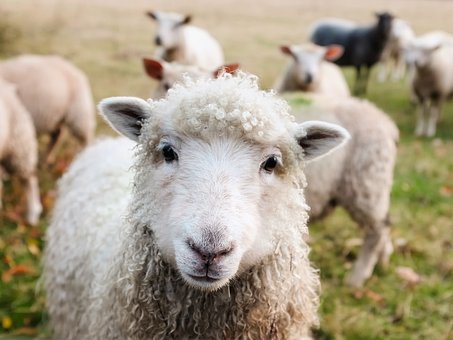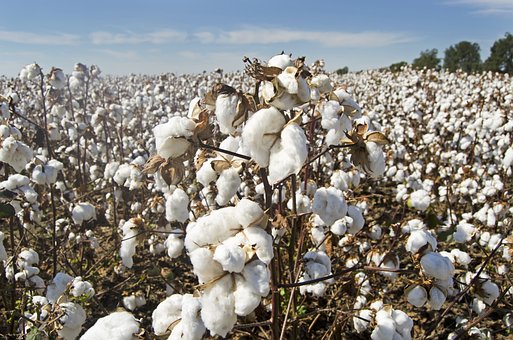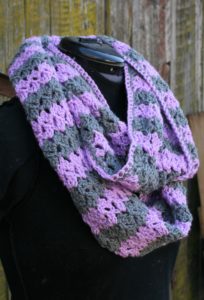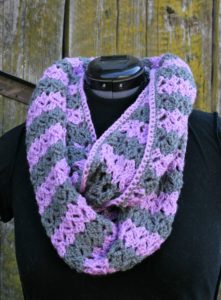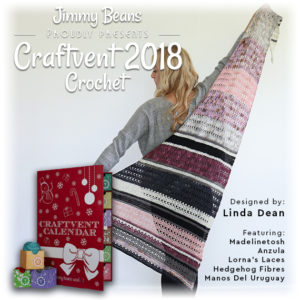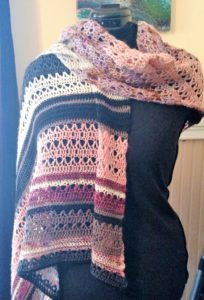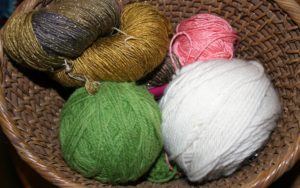 I am so honored to be invited to participate in this years Moogly CAL 2018 Afghan Block! This is the last square for 2018, find all the rest here, and complete your own throw using one of each square.
I am so honored to be invited to participate in this years Moogly CAL 2018 Afghan Block! This is the last square for 2018, find all the rest here, and complete your own throw using one of each square.
This year I have been playing with miter squares, and thought I would share the skill with you. A miter square is worked from two outside edges, with a decrease at the corner, until no stitches are left on either edge, creating a square.
However with this design, I then added to two edges to create an effect that is similar to a look of a square atop a square, or some say even an arrow.
The name is derived from one of my students, Ann. She is my world traveler that shares stories of all of the exotic lands she has visited. She is also a former high school mathematics instructor, and always keeps us on point with the the patterns and the various ways that the stitch counts can be effected.
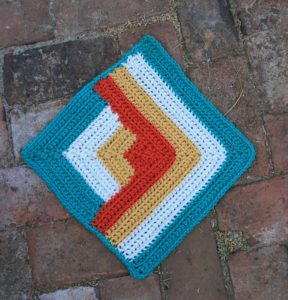
Ann’s Angles Square
Materials:
*Red Heart With Love: #1562 Jadeite (A), #1101 Eggshell (B), #1207 Cornsilk (C), #1971 Tigerlily (D)
*Hook J/10/ 6.00mm
Gauge
Square= 12″ x 12″ (30.5 x 30.5 cm)
Row 1: With A, ch 42, sc in 2nd ch from hook, sc in next 18 sts, sc3tog over the next 3 chs, sc in the last 19 chs, turn.
Row 2: Ch 1, flsc in same st, flsc in next 17 sts, sc3tog over next 3 sts, flsc in last 18 sts, turn.
Row 3: Ch 1, flsc in same st, flsc in next 16 sts, sc3tog over next 3 sts, flsc in last 17 sts, turn.
Row 4: Ch 1, flsc in same st, flsc in next 15 sts, sc3tog over next 3 sts, flsc in last 16 sts, turn.
Row 5: Ch 1, flsc in same st, flsc in next 14 sts, sc3tog over next 3 sts, flsc in last 15 sts, change to color B, turn.
Row 6: Ch 1, flsc in same st, flsc in next 13 sts, sc3tog over next 3 sts, flsc in last 14 sts, turn.
Row 7: Ch 1, flsc in same st, flsc in next 12 sts, sc3tog over next 3 sts, flsc in last 13 sts, turn.
Row 8: Ch 1, flsc in same st, flsc in next 11 sts, sc3tog over next 3 sts, flsc in last 12 sts, turn.
Row 9: Ch 1, flsc in same st, flsc in next 10 sts, sc3tog over next 3 sts, flsc in last 11 sts, turn.
Row 10: Ch 1, flsc in same st, flsc in next 9 sts, sc3tog over next 3 sts, flsc in last 10 sts, change to color C, turn.
Row 11: Ch 1, flsc in same st, flsc in next 8 sts, sc3tog over next 3 sts, flsc in last 9 sts, turn.
Row 12: Ch 1, flsc in same st, flsc in next 7 sts, sc3tog over next 3 sts, flsc in last 8 sts, turn.
Row 13: Ch 1, flsc in same st, flsc in next 6 sts, sc3tog over next 3 sts, flsc in last 7 sts, turn.
Row 14: Ch 1, flsc in same st, flsc in next 5 sts, sc3tog over next 3 sts, flsc in last 6 sts, turn.
Row 15: Ch 1, flsc in same st, flsc in next 4 sts, sc3tog over next 3 sts, flsc in last 5 sts, change to color D, turn.
Row 16: Ch 1, flsc in same st, flsc in next 3 sts, sc3tog over next 3 sts, flsc in last 4 sts, turn.
Row 17: Ch 1, flsc in same st, flsc in next 2 sts, sc3tog over next 3 sts, flsc in last 3 sts, turn.
Row 18: Ch 1, flsc in same st, flsc in next 1 st, sc3tog over next 3 sts, flsc in last 2 sts, turn.
Row 19: Ch 1, flsc in same st, sc3tog over next 3 sts, flsc in last st, turn.
Row 20: Ch 1, sc3tog over next 3 sts, fasten off.
Working over the ends of rows.
Row 21: With color D, join to either of edge of Row 1, ch 1, evenly work 19 sc sts across edge, 3 sc in last stitch of row 20, working down the other edge or rows, evenly work 19 sc sts across edge, turn.
Row 22: Ch 1, flsc in same st, flsc in next 19 sts, 3 sc in next st, flsc in next 20 sts, turn.
Row 23: Ch 1, flsc in same st, flsc in next 20 sts, 3 sc in next st, flsc in next 21 sts, turn.
Row 24: Ch 1, flsc in same st, flsc in next 21 sts, 3 sc in next st, flsc in next 22 sts, change to color C, turn.
Row 25: Ch 1, flsc in same st, flsc in next 22 sts, 3 sc in next st, flsc in next 23 sts, turn.
Row 26: Ch 1, flsc in same st, flsc in next 23 sts, 3 sc in next st, flsc in next 24 sts, turn.
Row 27: Ch 1, flsc in same st, flsc in next 24 sts, 3 sc in next st, flsc in next 25 sts, turn.
Row 28: Ch 1, flsc in same st, flsc in next 25 sts, 3 sc in next st, flsc in next 26 sts, change to color B, turn.
Row 29: Ch 1, flsc in same st, flsc in next 26 sts, 3 sc in next st, flsc in next 27 sts, turn.
Row 30: Ch 1, flsc in same st, flsc in next 27 sts, 3 sc in next st, flsc in next 28 sts, turn.
Row 31: Ch 1, flsc in same st, flsc in next 28 sts, 3 sc in next st, flsc in next 29 sts, turn.
Row 32: Ch 1, flsc in same st, flsc in next 29 sts, 3 sc in next st, flsc in next 30 sts, change to color A, turn.
Row 33: Ch 1, flsc in same st, flsc in next 30 sts, 3 sc in next st, flsc in next 31 sts, turn.
Row 34: Ch 1, flsc in same st, flsc in next 31 sts, 3 sc in next st, flsc in next 32 sts, turn.
Row 35: Ch 1, flsc in same st, flsc in next 32 sts, 3 sc in next st, flsc in next 33 sts, turn.
Row 36: Ch 1, flsc in same st, flsc in next 33 sts, 3 sc in next st, flsc in next 33 sts, 3 sc in next st, working on edge of Rows 21-36 evenly sc across to the unused loops of the beg ch of row 1, sc in the next 20 unused loops, 3 sc in next st, sc in the next 20 unused loops, continue evenly sc across the ends of Rows 21-36, 2 sc in last st, sl st to join. Fasten off, weave in ends, block.

